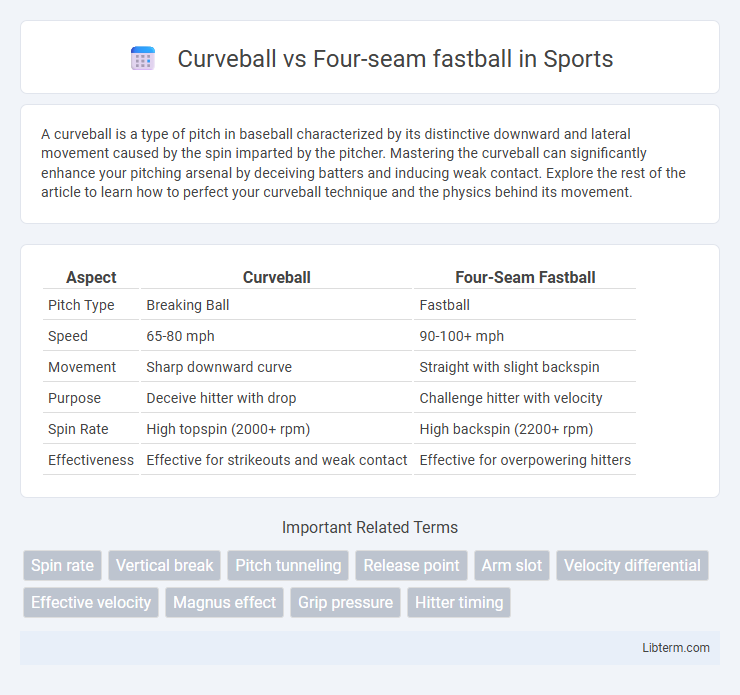A curveball is a type of pitch in baseball characterized by its distinctive downward and lateral movement caused by the spin imparted by the pitcher. Mastering the curveball can significantly enhance your pitching arsenal by deceiving batters and inducing weak contact. Explore the rest of the article to learn how to perfect your curveball technique and the physics behind its movement.
Table of Comparison
| Aspect | Curveball | Four-Seam Fastball |
|---|---|---|
| Pitch Type | Breaking Ball | Fastball |
| Speed | 65-80 mph | 90-100+ mph |
| Movement | Sharp downward curve | Straight with slight backspin |
| Purpose | Deceive hitter with drop | Challenge hitter with velocity |
| Spin Rate | High topspin (2000+ rpm) | High backspin (2200+ rpm) |
| Effectiveness | Effective for strikeouts and weak contact | Effective for overpowering hitters |
Introduction to Curveball and Four-Seam Fastball
The curveball is a breaking pitch characterized by a significant downward spin and slower velocity, designed to deceive batters with its sharp, arcing trajectory. The four-seam fastball, known for its straight path and top speed ranging from 90 to 100 mph, relies on backspin to maintain lift and maximize velocity. Understanding the physics and grip differences between these pitches is essential for pitchers aiming to diversify their arsenal and outwit opponents.
Key Differences in Pitch Grip
The key difference in grip between a curveball and a four-seam fastball lies in the finger placement and pressure applied on the baseball seams. For a four-seam fastball, pitchers grip across the horseshoe-shaped seam with the index and middle fingers perpendicular to the seams, maximizing backspin and velocity. In contrast, a curveball grip places the middle finger along the bottom seam with the thumb underneath, allowing the pitcher to snap the wrist downward for significant topspin and sharp downward break.
Distinct Throwing Mechanics
The Curveball features a pronounced wrist snap and downward spin generated by a grip along the ball's seams, creating a sharp, arcing trajectory. In contrast, the Four-seam fastball is delivered with a straighter wrist motion and a grip across four seams, maximizing backspin for velocity and a straighter, rising flight path. These distinct throwing mechanics directly influence pitch speed, movement, and batter deception.
Variations in Ball Movement
Curveballs exhibit a pronounced downward and lateral break due to the topspin imparted by the pitcher's grip and arm angle, creating a sharp, sweeping movement that deceives hitters. Four-seam fastballs maintain a straighter, more direct trajectory with minimal lateral movement, relying on backspin to maximize velocity and create a rising illusion. The significant variation in ball movement between the sweeping curveball and the straight, high-velocity four-seam fastball challenges batters to adjust timing and swing path.
Speed Comparison: Curveball vs Four-Seam Fastball
A typical four-seam fastball averages between 90 to 95 mph, making it one of the fastest pitches in baseball, while a curveball usually ranges from 70 to 80 mph, significantly slower due to its emphasis on spin and break rather than velocity. The speed differential of approximately 15 to 25 mph between the four-seam fastball and curveball creates deception, disrupting the batter's timing and increasing the pitcher's effectiveness. This disparity in velocity combined with the curveball's pronounced downward movement contrasts sharply with the four-seam fastball's relatively straight trajectory and high speed.
Strategic Uses in Game Situations
Curveballs effectively disrupt a batter's timing by altering speed and trajectory, making them ideal for inducing weak contact or strikeouts in two-strike counts. Four-seam fastballs maximize velocity and pitch location, often employed early in the count to challenge hitters and set up secondary pitches. Strategic use of curveballs later in at-bats can exploit a batter's anticipation of fastballs, enhancing pitch sequencing and overall effectiveness.
Hitter’s Perspective and Reaction
Curveballs challenge hitters with their sharp downward break and slower velocity, requiring precise timing adjustments compared to four-seam fastballs. In contrast, four-seam fastballs deliver consistent, straight trajectories at higher speeds, pushing hitters to react quicker with a more aggressive swing. Successful hitters must distinguish these pitches early through keen observation of spin and release to optimize their reaction and contact quality.
Common Mistakes When Throwing Each Pitch
Throwing a curveball often involves the common mistake of improper wrist snap, which reduces the pitch's sharp downward break and can cause arm strain. Four-seam fastball errors typically include incorrect grip pressure or finger placement, leading to decreased velocity and unintended pitch movement. Consistent practice on proper mechanics enhances control and effectiveness for both pitches.
Training Tips for Mastering Both Pitches
Mastering the curveball and four-seam fastball requires focused training on grip, release, and arm mechanics to optimize pitch control and spin. Consistent bullpen sessions emphasizing proper wrist snap for the curveball and a firm, straight wrist for the four-seam fastball build muscle memory crucial for performance. Incorporating video analysis and targeted drills helps refine pitch dynamics and increase velocity and break precision.
Curveball and Four-Seam Fastball in MLB History
Curveballs and four-seam fastballs have been pivotal pitches in MLB history, defining pitching strategies and player reputations. The curveball's sharp downward break contrasts with the four-seam fastball's straight, high-velocity trajectory, making both essential for disrupting hitter timing. Legendary pitchers like Bert Blyleven excelled with curveballs, while Nolan Ryan's four-seam fastball remains one of the fastest and most feared in the sport's history.
Curveball Infographic

 libterm.com
libterm.com